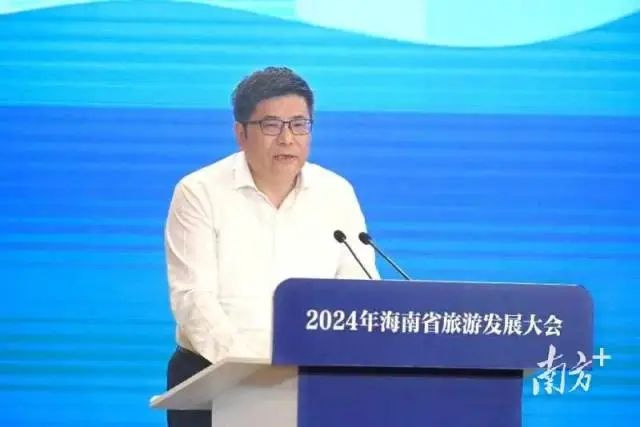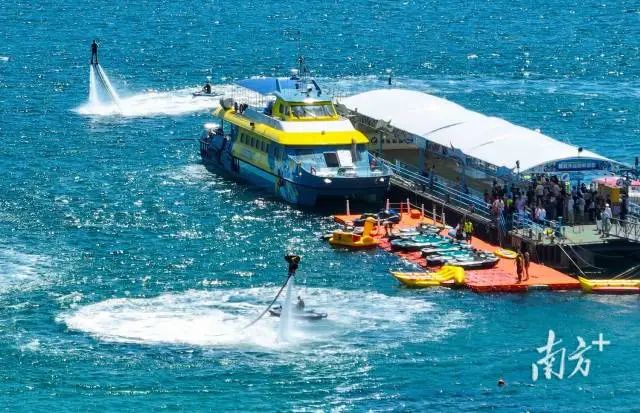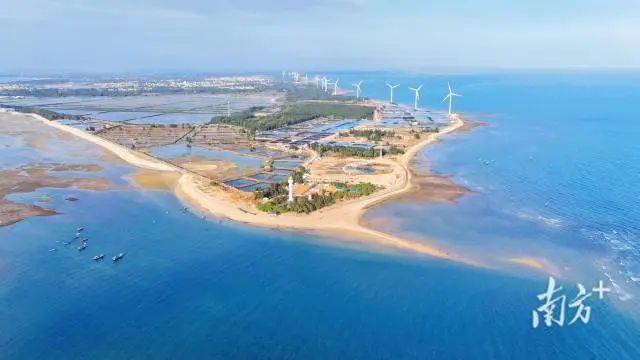On October 19, the Hainan Tourism Development Conference was held in Sanya. Dai Bin, president of the China Tourism Research Institute, proposed at the conference that the ocean is a new strategic space for building a strong tourism nation, a basic resource and emerging market for the modern tourism system, and an important innovation direction for the country's "15th Five-Year Plan" tourism industry planning.
Hainan and Guangdong are both coastal cities, and the two provinces are geographically close, have close ties, and have a long history. How can Guangdong and Hainan work together to promote the development of marine tourism? Nanfang Daily and Nanfang+ reporters interviewed Dai Bin, president of the China Tourism Academy. He said that with the in-depth promotion of the construction of the Guangdong-Hong Kong-Macao Greater Bay Area and the Hainan Free Trade Port, the cooperation between Guangdong and Hainan to promote the development of marine tourism mainly starts from three aspects: market cooperation, industrial coordination, and policy coordination.
Complementary advantages: Differences between Guangdong and Hainan create potential for cooperation
"From the perspective of cooperation, the two places can give full play to their respective advantages, which is a very accurate entry point." Dai Bin said that the two places have their own advantages and disadvantages in developing tourism. It is precisely because of their own advantages and disadvantages that Guangdong and Hainan need to cooperate.
From the perspective of the tourism market, Guangdong has a large population, a developed economy, active social and economic factors, and strong tourism consumption demand from residents. Market data during the National Day holiday showed that the average travel distance per person was about three hours by car, and the short-distance market is still the main market. Dai Bin believes that from this perspective, Guangdong's biggest advantage is its source of tourists, and the local area has a strong endogenous source market. In addition, Guangdong is connected by city clusters, and the city clusters are also each other's source markets.
 On October 19, the Hainan Tourism Development Conference was held in Sanya. At the conference, Dai Bin, president of the China Tourism Research Institute, gave a special report entitled "Building the Ocean into a New Strategic Space for a Tourism Powerhouse". Photo by Li Shaoxiong
On October 19, the Hainan Tourism Development Conference was held in Sanya. At the conference, Dai Bin, president of the China Tourism Research Institute, gave a special report entitled "Building the Ocean into a New Strategic Space for a Tourism Powerhouse". Photo by Li Shaoxiong
Hainan is more of a leisure and vacation destination, and tourists spend a long time there. Dai Bin mentioned that Hainan's tourist routes mainly run from Haikou to Sanya, with a highway around the island connecting them. "This means that Hainan is more likely to grasp tourists' consumption needs and give them a clearer portrait. The tourist market is more concentrated, simpler, and easier to grasp."
From the perspective of industry, Dai Bin believes that the infrastructure, public services, business environment and industrial chain of Guangdong's tourist destinations are very good in China. "When we talk about the development of tourism in a place, we can't just look at how many scenic spots and hotels it has. When our tourists today are more likely to visit tourist destinations as individual travelers, local subways, buses and even long-distance aviation and high-speed rail infrastructure are all crucial."
"One more person means one more pair of chopsticks", Dai Bin used this vivid metaphor to describe the development of tourism in Guangdong. He believes that from the perspective of the business environment, Guangdong is dominated by industry and commerce, especially Guangzhou, which is a commercial city with developed industry and commerce. Many supporting facilities are endogenous. "Guangdong is originally a large tourist destination shared by hosts and guests, and the development of tourism is a by-product."
Guangdong and Hainan work together to achieve marine tourism integration in three aspects
Dai Bin believes that the cooperation between Guangdong and Hainan in developing marine tourism should mainly focus on three aspects: market cooperation, industrial collaboration and policy coordination.
From the market perspective, Dai Bin mentioned that, first, we need to strengthen market coordination and create a regional tourism development strategy that integrates Guangdong and Hainan. "As the Guangdong-Hainan channel becomes more and more complete, there should be two types of cooperation at the market level. Tourists from Guangdong go to Hainan, and permanent tourists from Hainan go to Guangdong, forming an endogenous large market. Second, we need to create a multi-stop route. Around the route of Hainan, Guangdong, Hong Kong and Macao, we will form a large marine tourism destination. Third, we need to strengthen the flow of capital, technology, talent and other factors, and allow resource factors to flow freely in this region under the framework of marine tourism integration."
From the policy point of view, the investment access is fully liberalized, the shortest negative list for foreign investment is implemented; two 15% tax preferential policies; the domestic sales duty-free policy for goods with processing value-added exceeding 30%... Dai Bin said that Hainan's policies are conducive to promoting tourism and are sustainable, focusing on the development of tourism. "Therefore, the cooperation between Guangdong and Hainan is also conducive to mutual learning of policies among various places, and there may even be a major breakthrough in the flow of Guangdong, Hong Kong and Macao."
From an industrial perspective, Dai Bin believes that strategic coordination between Guangdong, Hong Kong, Macao and Hainan is a good choice. For example, as a "five-star hotel floating on the sea", cruise ships have become a new lifestyle for high-quality ocean vacations for the general public. With the acceleration of the construction of cruise ports in Sanya, Shenzhen, Hong Kong and other places and the improvement of their operating levels, there will be more international cruise routes starting, ending and docking to meet the people's growing new demand for cruise tourism.
 On October 19, tourists experienced the "Water Flying Man" project in Dadonghai, Sanya, Hainan. Photo by Zhang Mao
On October 19, tourists experienced the "Water Flying Man" project in Dadonghai, Sanya, Hainan. Photo by Zhang Mao
In addition, we need to consciously position different cities to achieve staggered development. Dai Bin mentioned that for Hainan, Sanya and the eastern coastal cities and counties should be cultivated into the country's main diplomatic venues, island reception halls and world-class tourist resorts; Sansha should be included in the national tourism development "15th Five-Year Plan" to create the world-class marine tourism city with the largest land area. For Guangdong, many coastal cities also need to be positioned to achieve staggered development.
Collaborative development of Guangdong-Hainan cooperation reveals new direction for marine tourism development
Regarding the future development trend of marine tourism in my country, Dai Bin said that cooperation between Guangdong and Hainan is one direction. First, through the development of marine tourism, the industry upgrading and structural optimization of cities adjacent to the coast will be driven; second, through air and sea routes, coastal high-speed transportation networks and inland routes such as the Pearl River, the Greater Bay Area and the Qiongzhou Strait will be connected in series, so that city cruise ships, inland yachts, sea cruises and aviation routes can support each other. In this way, a new spatial pattern of a tourism powerhouse with "land-sea linkage and three-dimensional travel" will be constructed.
 The coastal scenery of Nanji Village, Xuwen County, Zhanjiang City. Photo by Chen Huan
The coastal scenery of Nanji Village, Xuwen County, Zhanjiang City. Photo by Chen Huan
But what are the problems we are facing? "Dai Bin mentioned that the situation of one strong country and multiple poles still exists, so how to coordinate among different regions is a problem. Take neighboring Vietnam as an example. Although it has developed rapidly in the past two years, it is still a growing market overall, so this involves not only domestic coordination, but also international coordination.
In addition, Dai Bin said that the synergistic effect of "land-sea linkage" is not obvious at present. Except for a few cities such as Sanya, seaside and island tourist destinations are mainly for enjoying sea breeze, sea view, sea bathing and eating seafood. The characteristics of "sea-sea similarity" are still quite obvious. From the supply side and policy side, due to the lack of cultural arrangement, market research and industry connection of coastal cities and their hinterlands, marine tourism is limited to the primary development of seaside and offshore.
"The path of cooperation between Guangdong and Hainan still needs to be explored and developed, but it is these challenges that give marine tourism a more unique charm and value. Every time we work together will become a powerful driving force for the development of marine tourism," said Dai Bin.
Author | Dai Bin Source | Nan Fang Daily, Nan Fang + Client Editor | Liu Xin Please indicate the source for reprinting